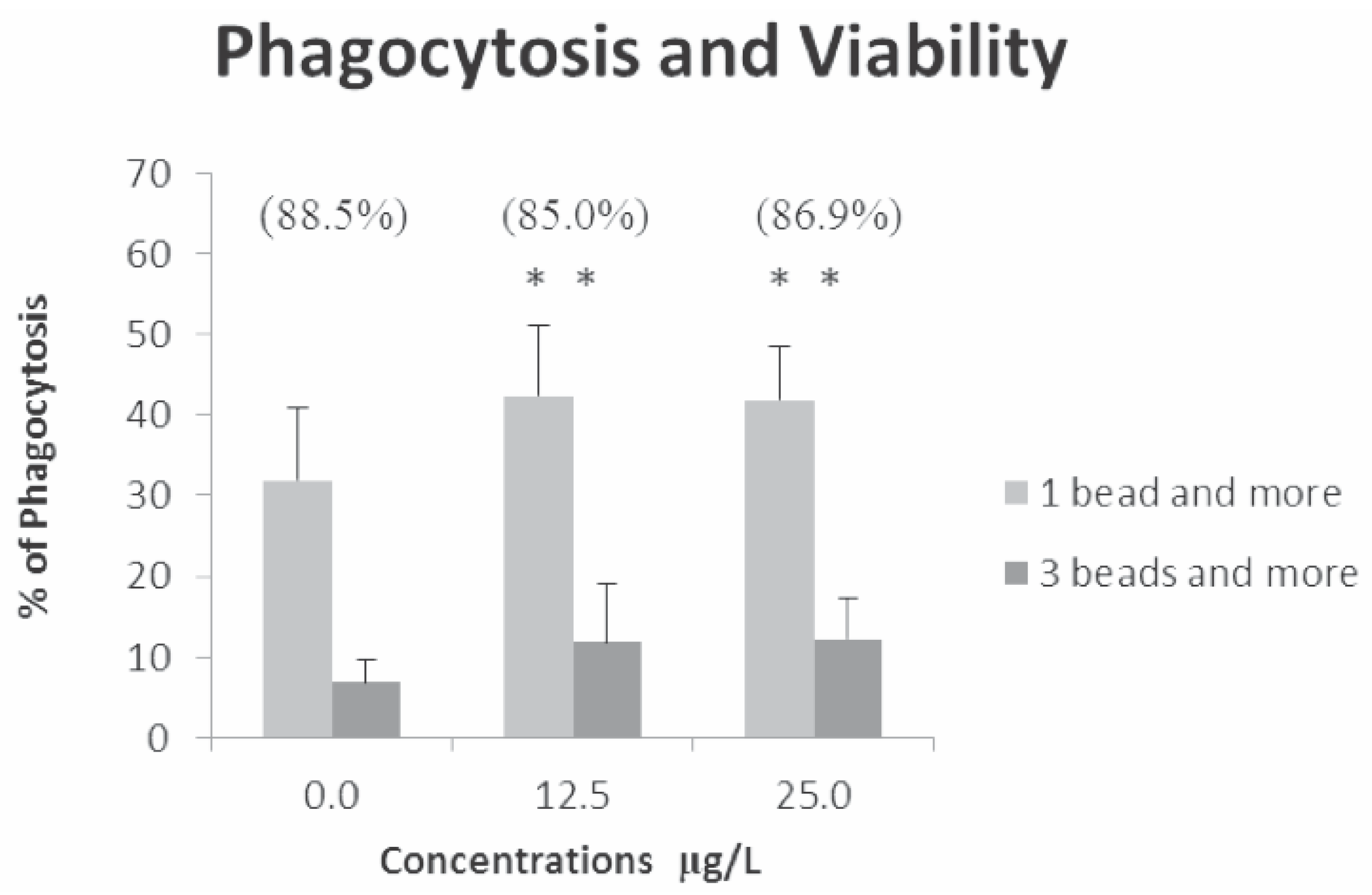Effects of Various Illicit Drugs on Immune Capacity of Blue Mussel (Mytilus edulis) †
Introduction
Materials and Methods
Test system
Hemolymph collection, viability and cellularity
Phagocytosis
Exposure protocol
Statistical analysis
Results
Solvants
Individual drugs and mixture
Discussion and Conclusions
Acknowledgments
References
- Rosi-Marshall, EJ; Snow, D; Bartelt-Hunt, SL; Paspalof, A. A review of ecological effects and environmental fate of illicit drugs in aquatic ecosystems. J Hazard Mater 2014. [Epub Ahead of Print]. [Google Scholar]
- Pal, R; Megharaj, M; Kirkbride, KP; Naidu, R. Illicit drugs and the environment: a review. Sci. Total Environ 2013, 463-464, 1079–92. [Google Scholar]
- Rutsch, M; Rieckermann, J; Lindberg, RH; Phan, C; Tysklind, M; Larsson, DGJ. Contamination of surface, ground and drinking water from pharmaceutical production. Environ Toxicol Chem 2009, 28, 2522–7. [Google Scholar]
- Kaushal, SS; Groffman, PM; Band, LE; Elliott, EM; Shields, CA; Kendall, C. Tracking non-point source nitrogen pollution in human-impacted watersheds. Environ Sci Technol 2011, 45, 8225–32. [Google Scholar]
- Munoz, I; Lopez-Doval, JC; Ricart, M; Villagrasa, M; Brix, R; Geiszinger, A; et al. Bridging levels of pharmaceuticals in river water with biological community structure in the Llobregat river bain (Northest Spain). Environ Toxicol Chem 2009, 28, 2706–14. [Google Scholar]
- Rosi-Marshall, EJ; Kincaid, D; Bechtold, HA; Royer, TV; Rojas, M; Kelly, JJ. Pharmaceuticals suppress algal growth and microbial respiration and alter bacterial communities of stream biofilms. Ecol Appl 2013, 23, 583–93. [Google Scholar]
- Drury, B; Rosi-Marshall, EJ; Kelly, JJ. Wasterwater treatment effluent reduces the abundance and diversity of benthic bacterial communities in urban and suburban rivers. Appl Environ Microbiol 2013, 79, 1897. [Google Scholar]
- Brodin, T; Fick, J; Jonsson, M; Klaminder, J. Dilute concentrations of a psychiatric drug alter behavior of fish from natural populations. Science 2013, 339, 814–5. [Google Scholar]
- Brousseau, P; Payette, Y; Tryphonas, H; Blakley, B; Boermans, H; Flipo, D; et al. Manual of immunological methods. CRC Press: Boca Raton, FL, 1998. [Google Scholar]
- Jonsson, M; Fick, J; Klaminder, J; Brodin, T. Antihistamines and aquatic insects: bioconcentration and impacts on behavior in damselfly larvae (Zygoptera). Sci Total Environ 2014, 472, 108–11. [Google Scholar]
- Radulovic, NS; Blagojevic, PD; Stojanovic-Radic, ZZ; Stojanovic, NM. Antimicrobial plant metabolites: structural diversity and mechanism of action. Curr Med Chem 2013, 20, 932–52. [Google Scholar]
- Parolini, M; Binelli, A. Oxidative and genetic responses induced by Δ-9-tetrahydrocannabinol (Δ-9-THC) to Dreissena polymorpha. Sci Total Environ 2014, 468-469, 68–76. [Google Scholar]
- Gagné, F; André, C; Gélinas, M. Neurochimical effects of benzodiazepine and morphine on freshwater mussels. Comparat Biochem Physiol Part C 2010, 152, 207–14. [Google Scholar]
- Schroder, K; Hertzog, PJ; Ravasi, T; Hume, DA. Interferon-gamma: an overview of signals, mechanisms and functions. J Leukocyte Biol 2004, 75, 163–89. [Google Scholar]
- Newman, LS; Mroz, MM; Balkissoon, R; Maier, LA. Beryllium sensitization progresses to chronic Beryllium disease. Am J Respir Crit Care Med 2005, 171, 54–60. [Google Scholar]
- Klatzmann, D; Abbas, AK. The promise of low-dose interleukin-2 therapy for autoimmune and inflammatory diseases. Nature Rev Immunol 2015, 15, 283–94. [Google Scholar]
- Bahadar, H; Abdollahi, M; Maqbool, F; Baeeri, M; Niaz, K. Mechanistic overview of immune modulatory effects of environmental toxicants. Inflamm Allergy Drug Targets 2014, 13, 382–6. [Google Scholar]
- Suliman, O; Ali, D; Alarifi, S; Harrath, AH; Mansour, L; Alwasel, SH; et al. Evaluation of cytotoxic, oxidative stress, proinflammatory and genotoxic effect of silver nanoparticles in human lung epithelial cells. Environ Toxicol 2015, 30, 149–60. [Google Scholar]

©Copyright C. Brousseau-Fournier et al., 2015. Licensee PAGEPress, Italy. This work is licensed under a Creative Commons Attribution NonCommercial 3.0 License (CC BY-NC 3.0).
Share and Cite
Brousseau-Fournier, C.; Côté, C.; Pharand, P.; Gagné, J.P.; Lajeunesse, A.; Fournier, M.; Brousseau, P. Effects of Various Illicit Drugs on Immune Capacity of Blue Mussel (Mytilus edulis). J. Xenobiot. 2015, 5, 5770. https://doi.org/10.4081/xeno.2015.5770
Brousseau-Fournier C, Côté C, Pharand P, Gagné JP, Lajeunesse A, Fournier M, Brousseau P. Effects of Various Illicit Drugs on Immune Capacity of Blue Mussel (Mytilus edulis). Journal of Xenobiotics. 2015; 5(2):5770. https://doi.org/10.4081/xeno.2015.5770
Chicago/Turabian StyleBrousseau-Fournier, C., C. Côté, P. Pharand, J.P. Gagné, A. Lajeunesse, M. Fournier, and P. Brousseau. 2015. "Effects of Various Illicit Drugs on Immune Capacity of Blue Mussel (Mytilus edulis)" Journal of Xenobiotics 5, no. 2: 5770. https://doi.org/10.4081/xeno.2015.5770
APA StyleBrousseau-Fournier, C., Côté, C., Pharand, P., Gagné, J. P., Lajeunesse, A., Fournier, M., & Brousseau, P. (2015). Effects of Various Illicit Drugs on Immune Capacity of Blue Mussel (Mytilus edulis). Journal of Xenobiotics, 5(2), 5770. https://doi.org/10.4081/xeno.2015.5770



